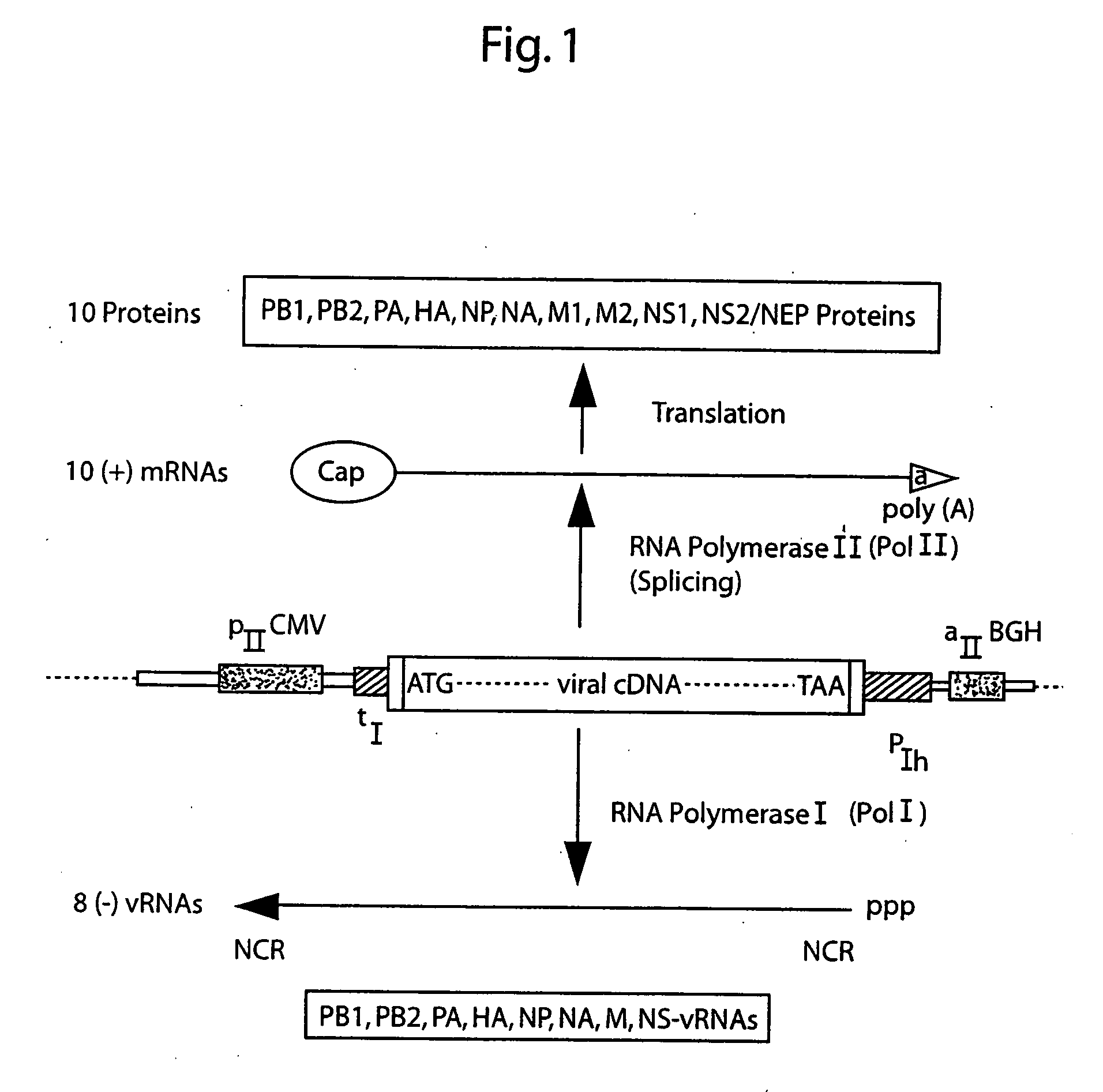DNA transfection system for the generation of infectious influenza virus
a technology of infectious influenza virus and transfection system, which is applied in the direction of immunological disorders, drug compositions, fungi, etc., can solve the problems of complex replication cycle, limited practical value of these methods, and limited use of this system, so as to increase the potency and elicit protective immunity
- Summary
- Abstract
- Description
- Claims
- Application Information
AI Technical Summary
Benefits of technology
Problems solved by technology
Method used
Image
Examples
example 1
“Ambisense” Approach for the Generation of Influenza A Virus: vRNA and mRNA Synthesis from One Template
[0136] As a first step in reducing the number of plasmids, this Example reports the construction and transfection of plasmids containing both the pol I and pol II-promoter on the same plasmid and presents evidence that this system allows the expression of vRNA and protein from one template. This Example has been published (Hoffmann et al., Virology 2000, 267:310).
Materials and Methods
[0137] Cloning of plasmids. All cloning and PCR reactions were performed according to standard protocols. Briefly, the expression plasmids for the polymerase complex genes of A / WSN / 33 were derived from pcDNA3 (Invitrogen) containing the immediate early promoter of the human cytomegalovirus (CMV) and the poly A site of the gene encoding bovine growth hormone (BGH). The viral cDNAs were derived from the plasmids pWNP 143, pWSNPA3, pWSNPB2-14, pGW-PB1 to yield the expression constructs pHW25-NP, pHW23-...
example 2
Construction of Recombinant Influenza A Viruses from a Minimal Plasmid-Based System
[0153] This example describes use of the plasmid-based transfection system for the rescue of influenza A virus entirely from cloned cDNA. Unlike established plasmid-based systems, this system for the generation of influenza A virus employs the construction and transfection of only eight expression plasmids, each containing one copy of a different viral cDNA corresponding to a viral gene segment. This reverse-genetics system reduces the number of plasmids required for the recovery of influenza A viruses and allows the predictable and efficient generation of reassortment viruses.
Materials and Methods
[0154] Cloning of plasmids. The plasmid pHW2000 (FIG. 3A) was derived from pHW12 (Example 1). The pHW2000 cloning vector contains 225 bp of the human pol I promoter and 33 bp of the murine terminator sequence separated by two BsmBI sites. The pol I promoter and terminator elements are flanked by a truncat...
example 3
RNA Pol I / Pol II System for the Generation of Influenza B Virus Entirely from Cloned cDNA
[0166] Influenza A and B viruses each contain eight segments of single stranded RNA with negative polarity (for review see Lamb and Krug, “Orthomyxoviridae: The viruses and their replication”; in Fields (Ed.), Virology; p1353-1395). Unlike influenza A, the eight segments of influenza B encode 11 proteins. The three largest genes code for the components of the RNA polymerase, PB1, PB2 and PA; segment 4 encodes the haemagglutinin. Segment 5 encodes the nucleoprotein, the major structural component associated with viral RNA, segment 6 encodes the neuraminidase (NA) and the NB protein. Both proteins, NB and NA, are translated from overlapping reading frames of a biscistronic mRNA. Segment 7 of influenza B also encodes two proteins: BM1 and BM2. The smallest segment encodes two products: NS1 is translated from the full length RNA, while NS2 is translated from a spliced mRNA.
[0167] Construction of e...
PUM
| Property | Measurement | Unit |
|---|---|---|
| Angle | aaaaa | aaaaa |
| Strain point | aaaaa | aaaaa |
Abstract
Description
Claims
Application Information
 Login to View More
Login to View More - R&D
- Intellectual Property
- Life Sciences
- Materials
- Tech Scout
- Unparalleled Data Quality
- Higher Quality Content
- 60% Fewer Hallucinations
Browse by: Latest US Patents, China's latest patents, Technical Efficacy Thesaurus, Application Domain, Technology Topic, Popular Technical Reports.
© 2025 PatSnap. All rights reserved.Legal|Privacy policy|Modern Slavery Act Transparency Statement|Sitemap|About US| Contact US: help@patsnap.com



